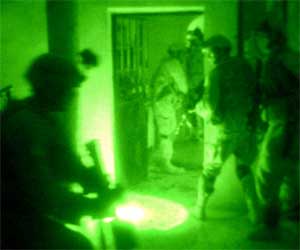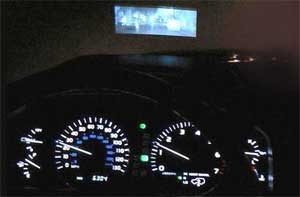Night vision devices (NVDs) have allowed humans to easily blend into and exploit an environment that was once only conquered through the use of flashlights and flood lamps. Whether in goggle or binocular form, these devices have given people a significant edge, first in military combat and more recently in surveillance, security, and rescue operations. As NVDs continue to be modified and improved, they have found applications in ocular surgeries and are currently being researched for use in automobiles and pedestrian detection. The history and technology behind NVDs is addressed, as well as modern and future applications.
Introduction
Like many creatures on this planet, we rely strongly on our eyes to interact with our surroundings. Yet, our vision pales in comparison to those of many other species. Among the animals that use their sight for survival, falcons have sharper vision, bees see more colors, and cats excel in the dark. What we lack physically, however, is often compensated through our ability to engineer enhancements to the human body equal to and sometimes exceeding what is available in nature.
Among these advancements are the night vision devices (NVDs) that have allowed humans to easily blend into and exploit an environment that was once only accessed through the use of flashlights and flood lamps. Whether in goggle or binocular form, these devices have given a significant edge to humans, first in military combat and more recently in surveillance, security, and rescue operations (see Fig. 1). As NVDs continue to be modified and improved, they have even found applications in ocular surgeries and are currently being explored for use in automobiles and pedestrian detection.
A Focus on the History
Before becoming such a widely-used technology, NVDs were originally the military’s answer to night combat. In World War I, large, power-guzzling search lights were used to dispel the night, illuminating both enemies and allies, which could often be counter-productive. By World War II, the first crude NVDs, dubbed Generation 0, were developed using lamps with filters that only passed infrared light. Since infrared is invisible to the human eye, soldiers could easily carry and use image converter tubes that changed the infrared light into the visible spectrum and allowed only the users to see in the desired areas [1]. However, this was still an active form of illumination that could be exploited by both sides of the battle and was thus used sparingly.
It was not until the Vietnam War that passive NVDs were developed and widely used. These devices were considered passive because they did not require an external source of infrared illumination but could, instead, amplify any reflected light (both infrared and visible light) from sources like the moon and the stars [2]. The new technology was labeled Generation I and was significantly more effective in terms of covertness in warfare. However, the dependence of Generation I on ambient light was still problematic on moonless or cloudy nights. Through the late 1900s, this issue was addressed and resolved in Generations II and III, both of which focused on magnifying very small amounts of light using an image intensifier tube (instead of an image converter tube) and reliably producing images in higher resolutions. These improved NVDs are still in use today in both military and civilian applications.
Illuminating the Process
Current NVDs consist of five main components in the image intensifier tube: a photocathode, a microchannel plate (MCP), a phosphor screen, and two ocular lenses for collecting, magnifying, and focusing the images. The first lens captures both visible light and infrared radiation. The photons of light hit the photocathode, which absorbs the energy of the photons and emits electrons with a corresponding energy. These electrons then collide with the MCP which, through cascaded secondary emission, releases thousands of other electrons at the same energy. Cascaded secondary emission occurs when the original electrons collide with the side of the channels and excite the atoms along the wall. These excited atoms then release their own electrons, which repeat the process and go on to excite other atoms. The microchannels are actually angled five to eight degrees to encourage the necessary collisions [3].
After passing through the MCP, the greatly multiplied electrons finally collide with a phosphor screen placed at the end of the image intensifier tube. The phosphors are energized by the electrons and release photons to create the brightened and magnified image through the last lens on the way to the human eye. Most often, green phosphors are used because humans can differentiate the most shades of green, which results in more discernible detail (see Fig. 2).
Lighting the Way
These ghostly images continue to be practical for a variety of purposes. For the military, NVDs have consistently been modified and specialized for use ranging from covert ground operations to aviation, successfully creating stronger, smaller, lighter, and more versatile devices for our soldiers. For flight applications, NVDs also had to be adapted to mount on the special headgear required of pilots while taking into consideration their field of view. Other considerations were their ability to transition from relative darkness to brighter areas when flying over cities and towns, and the effect of the goggles on night reading of important maps and charts without refocusing the lenses [1]. One such device that was able to answer the military’s needs is the AN/AVS-6 Aviator’s Night Vision Imaging System (ANVIS). This light-weight, third generation model runs on AA batteries and is able to increase peripheral vision and even incorporate a display for digital maps and programmable flight information, including speed, direction, and altitude of the plane [1].
With its successful incorporation into military flight, civilian pilots in rescue operations who often fly through darkness and foul weather to reach their targets began using NVDs during their missions. These relatively small additions to the flight equipment require a few hours of training and produce potentially dramatic results, allowing medical pilots to spot their future patients in the dark as well as reducing the potential for medical helicopter crashes in already dangerous situations. This technology is estimated to already exist in 25% of the medical rescue helicopters in the United States with more seeking to incorporate the ANVIS NVDs into their programs [4].
Inevitably, this technology has even made its way to luxury automobiles, with many companies combining technologies to create night vision screens, infrared high beams, and even pedestrian-tracking capabilities [5]. These new enhancements can extend the visibility of drivers at night, and during fog and rain, to over 300 meters, which is comforting considering the 50 meters currently provided by regular headlights. It takes approximately 110 meters to completely stop from a speed of about 100 km/hr. The numbers are clearly working against night-time drivers, but with the incorporation of NVDs, this disadvantage is greatly decreased [6].
Costing an additional $3000 to consumers, these systems use active NVDs with infrared-emitting light bulbs near the headlights to illuminate the road ahead (see Fig. 3). Since the human eye cannot see infrared light, the bulbs can be pointed straight ahead, giving drivers with the right image converters a lit-up, albeit greenish, view of the road.
However, just as with any new technology, the addition of NVDs to civilian vehicles still needs to undergo extensive research and testing. Engineers will need to ensure that the additional screens do not become just another distraction that could take the attention of the driver off the road during a precarious moment. They will also need to avoid creating a false sense of security, causing drivers to relax their attention and even speed up, believing in the infallibility of NVDs. Even experienced emergency pilots require training before flying with such a system, so it is understandable that there may be some reservation in selling such a product with only an additional manual to read. However, with careful and responsible use, NVDs could reduce casualties in many different situations as well as have dramatic effects on how we view and interact with our environment.
A Bright Future
NVDs have proved to be extremely versatile in the current day and have brought maneuvering in combat, flight, and driving to a new level of safety and security. Where we once forged ahead blindly into the night, now both our armed forces and civilians alike are experiencing the ability of engineering to continue to bring light to the darkness and to exceed the physical limits of the human body. As new applications for NVDs continue to be found, research for this area thrives, pointing towards future advancements such as panoramic and color night vision goggles. We have much to look forward to in the field of night vision devices.






